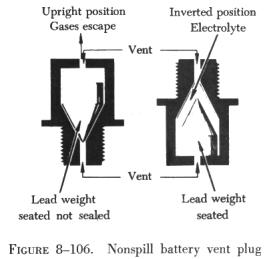Dale Young
Line Up and Wait
Other than not being certified, Why are auto batteries not used in airplanes?
Other than not being certified, Why are auto batteries not used in airplanes?
And one final reason: Airplane parts HAVE to be expensive. Car batteries aren't expensive enough
Dan

Not as resistant to vibration. No means of preventing acid spill if it's inverted.
I think the newer auto batteries that are totally sealed might be OK, but there's still the legalities of the whole thing. When a manufacturer specifies, for instance, the Gill G-25 battery in its parts listing, you need an STC to use the Concorde CB-25.
And one final reason: Airplane parts HAVE to be expensive. Car batteries aren't expensive enough
Dan

Now if Walmart started selling aircraft batteries We'd have a lot of planes that didn't start lol
Nah. Those are full of cheap Chinese electrons.
Dan
Chinese batteries (and regular pencils) are the only Chinese products without lead.



My Gill G-35 will handly spill acid all over the place if it's inverted. I'm not sure what you think is unique about aviation units.Not as resistant to vibration. No means of preventing acid spill if it's inverted.
I LOVE my Optima red top battery......... Oh yeah... I fly an experimental so I have choice.
Wow you run an Optima Red Top in your plane? That's some serious battery.. I've got them in a few cars, but run an Odyssey PC680 in the RV.
 :wink2:
:wink2:Other than not being certified, Why are auto batteries not used in airplanes?
Mainly because of the dimensions of the battery box car batteries won't fit.

Mainly because of the dimensions of the battery box car batteries won't fit.

My Gill G-35 will handly spill acid all over the place if it's inverted. I'm not sure what you think is unique about aviation units.


I did a pre-purchase on a 182 this summer for a friend. They had found a car battery that fit.
I was more worried that they had put that battery in because they kept killing batteries and it was cheaper to replace. Seems to me it might be cheaper to actually fix the problem than treat the symptom, even if you do it on the cheap
Now go look at the battery in a DA20, nice little Yuasa Motorcycle battery
Aviation batteries have lead-weighted vent valves to close the vents in the caps if the battery is tilted more than about 30 or 40 degrees.

This diagram shows an old style. The newer caps have a rod on the weight that extends through the vent hole into the cell, and a silicone seal disc on that. Shuts it off good. Looks like this:

If you're getting acid everywhere your caps aren't working, or perhaps the cells are overfilled. I never fill them more than halfway between the top of the plates and the bottom of the slip ring; the electrolyte expands a lot when the battery is charging and will rise in the cell. Filling to the bottom of the ring just results in electrolyte squirting out the vent.
Dan
